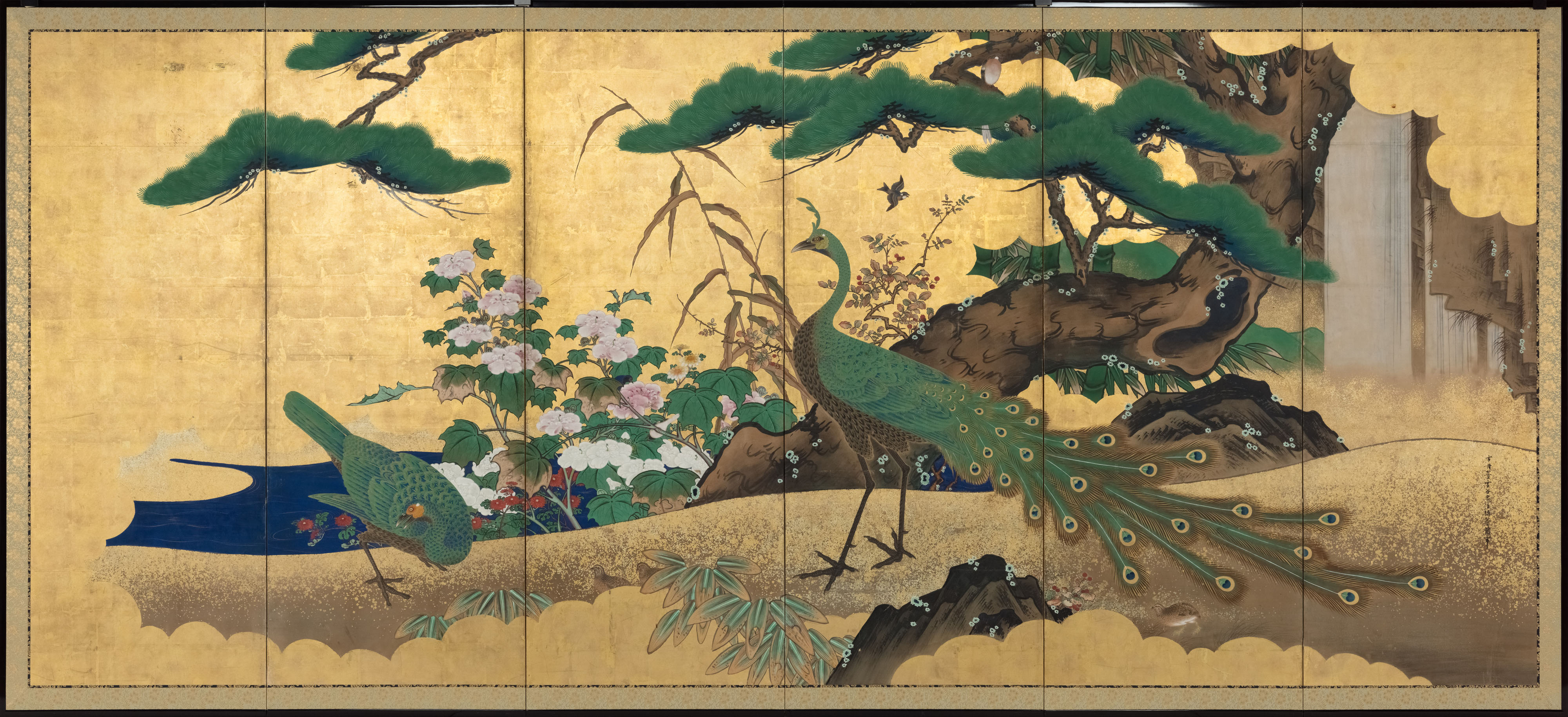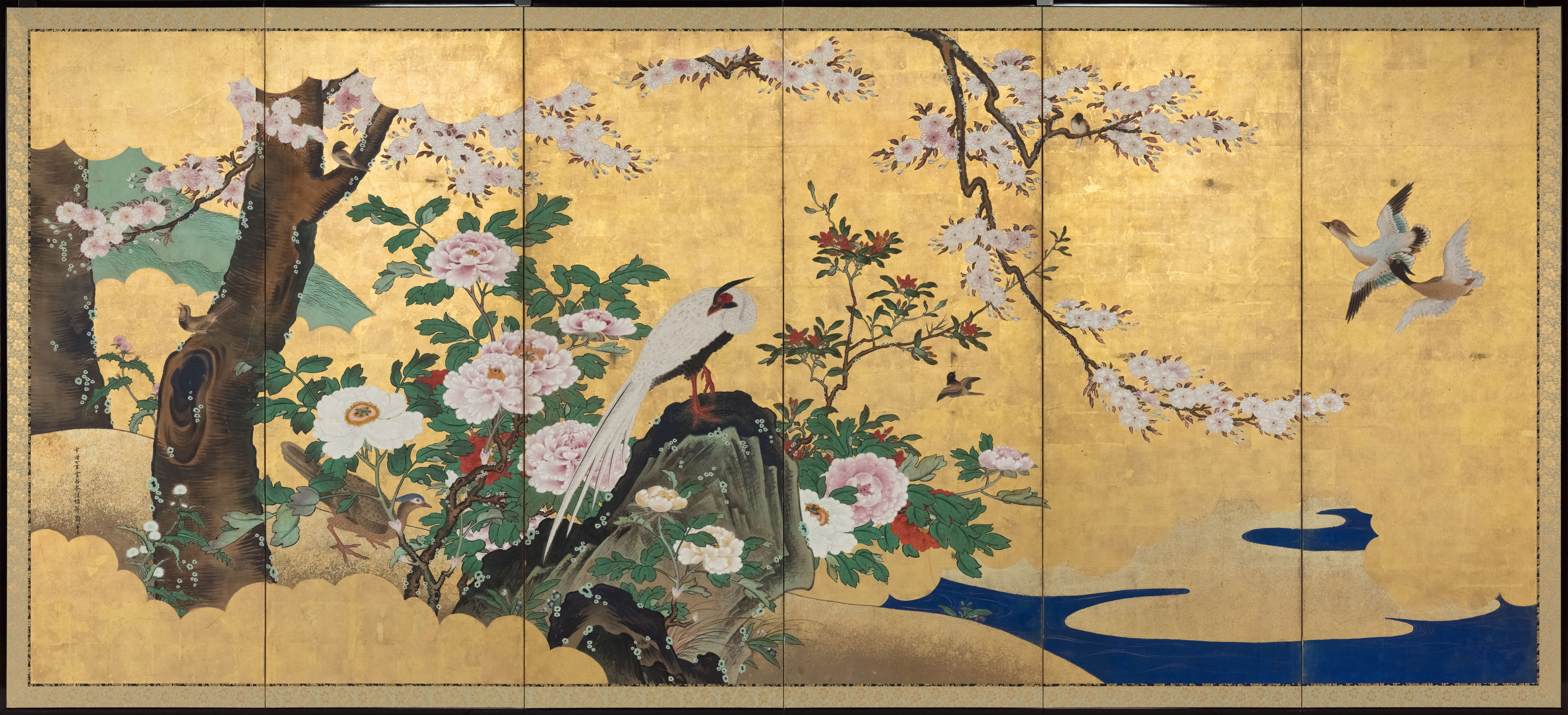
かちょうず 花鳥図
不詳(江戸時代 17-18世紀)
紙本金地着色
雲谷派5代・等鶴による、華やかな花鳥図屛風です。右隻にはどっしりとした幹をもつ松の樹を背に、2羽の雌雄の孔雀がたたずみ、芙蓉(ふよう)の花が彩りを添えます。左隻には巨岩に止まる白色の羽根が美しいキジを中心に、桜花と大輪の牡丹(ぼたん)、赤いツツジが咲き誇ります。孔雀には、緑色の緑青と群青の岩絵の具、金泥(金色の絵の具)を用いて、羽毛の線を1本1本ていねいに描いています。岩絵の具の原料である鉱物は、長登銅山(ながのぼりどうざん)(山口県美祢市)で採掘した銅を使用したものかもしれません。また、桜花は胡粉(ごふん)(貝殻を原料とする白い絵具)を塗り重ねて立体的に表しており、画面の装飾性をより高めています。
孔雀は「邪気を払う」、芙蓉は「栄華」、キジは「子孫繁栄」、牡丹は「富・幸福」と縁起の良い意味をもっており、祝いの席に映える屛風です。画面の署名には「雪舟七世」と書かれており、等鶴は雪舟から数えて7代目の画家であることをアピールしています。
雲谷等鶴【うんこく とうかく】
生没年 1674~?(延宝2年~?)
雲谷等益の四男・等璠(とうはん)の長男。父等璠は雲谷派3代・等與の養子となり、雲谷宗家を相続。等鶴は父の後を継いで雲谷派5代目となり「雪舟七世」を称し、萩を拠点に活動しました。元禄4年(1691)法橋(ほっきょう)に叙任。享保19年(1734)に一門の等徴に宗家を譲りました。江戸時代中期の雲谷派の主要な画家で、花鳥画を得意としました。
| 寸法 | [左]156.5×359.2/[右]156.2×358.8 cm |
|---|---|
| 形状 | 六曲屏風 |

Flowers and Birds
Color and gold leaf on paper
A gorgeous pair of six-panel folding screens by Tokaku, the 5th leader of the Unkoku School. The right-hand screen portrays a peahen and a peacock standing before a pine tree with a sturdy trunk, with white cotton roses variegating the scene. On the left-hand screen, a beautiful pheasant with white plumage is settling onto a big rock in the center of the painting, while around the bird, cherries, large-flowered peonies and red azaleas are blossoming in full glory. The peafowl are carefully depicted using a greenish ultramarine blue, ultramarine mineral pigment, and gold paint, with each feather’s vane precisely depicted. The substance used as a raw material for the mineral pigment may have been copper extracted from the Naganobori Copper Mine (Mine City, Yamaguchi Prefecture). The three-dimensional quality of the cherry blossoms is expressed by daubing on many layers of whitewash (made from seashells), further intensifying the decorative quality of this picture.
The birds and flowers depicted on these screens are signs of good luck. Specifically, peafowl “remove noxious vapors”; cotton roses “bring glory”; pheasants symbolize the “prosperity of one’s descendants”; and peonies stand for “wealth and happiness”. This pair of screens would be a perfect decoration to set off festive events. The signature, “Sesshu VII”, is written on this work. By using this signature, Tokaku, the creator of this work, declares that he is the 7th generation painter of the Sesshu School.
Unkoku Tokaku (1647 – ?)
Tokaku was the first son of Unkoku Tohan, who was himself the fourth son of Unkoku Toeki. Tokaku’s father, Tohan, was adopted as a son by Unkoku Toyo, the third leader of the Unkoku School and became the head of the Unkoku family. After his father’s retirement from the leadership of the family, Tokaku carried on his father’s position and became the 5th leader of the Unkoku School, calling himself Sesshu VII.
He was based in Hagi (the present-day Hagi City, Yamaguchi Prefecture). In 1691, he became hokkyo (the third highest rank in the hierarchy of Buddhist monks). He resigned his position as family leader in favor of Tocho, one of the disciples of the Unkoku School. Tokaku was one of the major painters of the Unkoku School in the mid-Edo period. His kacho-ga (a genre of paintings depicting flowers and birds as subjects) were particularly outstanding.
| Size | 156.5×359.2/156.2×358.8 cm |
|---|

花鳥圖
雲穀派第5代——等鶴繪製的華麗的花鳥圖屏風。右邊屏風上,一對雌雄孔雀立於枝幹粗壯的鬆樹前,芙蓉花點綴其間。左邊屏風上,美麗的白羽雉雞停在巨岩上,周圍盛開著櫻花、大朵牡丹以及紅色杜鵑。孔雀的羽毛是用綠青與群青的礦石顏料、加上金泥(金色的顏料),一根一根地精心繪製出來的。岩畫顏料的原料中使用的礦物,也許是長登銅山(山口縣美禰市)開采出來的銅。此外,用胡粉(以貝殼為原料的白色顏料)反複塗抹的櫻花,呈現出立體感,也提高了畫麵的裝飾性。
孔雀意為“驅邪”,芙蓉意為“榮華富貴”,山雞意為“子孫繁榮”,牡丹則寓意著“財富與幸福”,各種吉祥寓意說明這是在喜慶宴席上裝飾的屏風。畫麵上的署名“雪舟七世”,表明等鶴是雪舟之後第七代畫家。
雲穀 等鶴
生卒年 1674 – ?(延寶2年~?)
雲穀等益四子——等璠的長子。父親等璠成為雲穀派第3代——等與的養子,繼承了雲穀本家。等鶴繼承父親,成為雲穀派第五代傳人,號稱“雪舟七世”,以萩市為據點活動。元祿4年(1691年)敘任法橋(僧位)。享保19年(1734年)將本家讓給了同門的等征。作為江戶時代中期雲穀派的主要畫家,擅長花鳥畫。
| 尺寸 | 156.5×359.2/156.2×358.8 cm |
|---|

화조도
운코쿠파 제5대 당주, 도카쿠가 그린 화려한 화조도 병풍입니다. 오른쪽 병풍에는 묵직한 줄기를 가진 소나무를 배경으로 암수 한 쌍의 공작이 서있으며, 연꽃이 흥취를 돋우고 있습니다. 왼쪽 병풍에는 큰 바위에 드리운 백색의 날개가 아름다운 꿩을 중심으로 벚꽃과 송이가 큰 모란, 붉은 진달래가 그 자태를 자랑하고 있습니다. 공작은 녹색이 들어간 청녹색 그리고 군청색의 가루 물감과, 금니(금색의 물감)을 사용하여 깃털의 선을 하나하나 세심하게 그렸습니다. 가루 물감의 원료인 광물은 나가노보리동산(야마구치현 미네시 소재)에서 채굴한 동을 사용한 것으로 추측됩니다. 그리고 벚꽃은 호분(조개 껍데기를 원료로 하는 백색 안료)을 겹쳐 발라 입체적으로 표현하여, 그림 전체의 장식성을 보다 높였습니다.
공작은 「나쁜 기운을 물리치는 것」, 연꽃은 「영화」, 꿩은 「자손 번영」, 모란은 「부와 행복」이라는 좋은 기운의 의미를 가진 모티브이며, 따라서 이 병풍은 축하하는 자리에서 빛을 발하는 병풍입니다. 서명에는 「雪舟七世(셋슈칠세)」라 쓰여 있으며, 도카쿠는 셋슈에서 시작된 셋슈류의 7대째 화가인 것을 어필하고 있습니다.
운코쿠 도카쿠
생몰년 1674년 – ? (엔포2년 ~ ? )
운코쿠 도에키의 네번째 아들인 도한의 장남. 아버지 도한은 운코쿠파 제3대 당주인 도요의 양자로 들어가, 운코쿠 종가를 상속받았습니다. 도카쿠는 아버지의 뒤를 이어 운코쿠파 제5대 당주가 되어 「셋슈 7세」를 칭하며, 하기를 거점으로 활동했습니다. 1691년(겐로쿠4년) ‘법교(法橋)‘에 서임. 1734년(교호19년)에 일족인 도쵸에게 종가를 물려줍니다. 도카쿠는 에도시대 중기 운코쿠파의 주요한 화가로서, 화조화(花鳥画)에 특출함을 보였습니다.
| 치수 | 156.5×359.2/156.2×358.8 cm |
|---|


